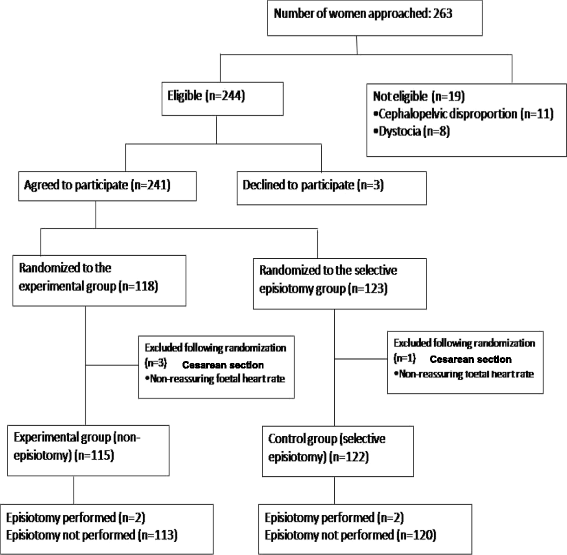Selective episiotomy vs. implementation of a non-episiotomy protocol: a randomized clinical trial
- PMID: 28438209
- PMCID: PMC5402639
- DOI: 10.1186/s12978-017-0315-4
Selective episiotomy vs. implementation of a non-episiotomy protocol: a randomized clinical trial
Erratum in
-
Correction to: Selective episiotomy vs. implementation of a non-episiotomy protocol: a randomized clinical trial.Reprod Health. 2017 Oct 24;14(1):135. doi: 10.1186/s12978-017-0399-x. Reprod Health. 2017. PMID: 29065891 Free PMC article. No abstract available.
Abstract
Background: Despite all the evidence corroborating the selective use of episiotomy and although routine use of the procedure is contraindicated, there are no evidences corroborating if episiotomy is necessary in any circumstance. The present clinical randomized trial was performed to compare maternal and perinatal outcomes in women submitted to a non-episiotomy protocol versus one of selective episiotomy.
Methods: An open-labelled, randomized clinical trial was carried out in a tertiary teaching hospital in Recife, Northeastern Brazil. Women in labor with a full-term live foetus, dilatation of 6 to 8 cm and cephalic presentation (vertex position) were included. Exclusion criteria consisted of bleeding disorders and an indication for a caesarean section. After signing the consent form, 241 women were randomized to a non-episiotomy protocol (the experimental group) or to a selective episiotomy group (the control group). No episiotomies were to be performed in the experimental group except under exceptional circumstances. In the control group, selective episiotomies were to be performed in accordance with the healthcare professionals' clinical judgement. Maternal and perinatal outcomes were evaluated. Ratio Risk (RR) and the 95% confidence interval (95% CI) were calculated for our outcomes.
Results: The analysis include 115 women assigned to a non-episiotomy protocol and 122 to selective episiotomy. There was no difference between the two groups with respect to maternal or perinatal outcomes. The episiotomy rate was similar (two cases in each group, about 1.7%), as was the duration of the second stage of labor, the frequency of perineal tears, severe perineal trauma, need for perineal suturing and blood loss at delivery.
Conclusions: A non-episiotomy protocol appears to be safe for mother and child, and highlights the need to investigate whether there is, in fact, any indication for this procedure.
Trial registration: This trial was registered at ClinicalTrials.gov under reference number ( NCT02178111 ).
Keywords: Episiotomy; Perineum; Randomized controlled trial; Vaginal delivery.
References
-
- World Health Organization Division of Family Health Maternal Health and Safe Motherhood. Care in normal birth: a practical guide. Report of a technical working group. World Health Organisation, 1996. http://apps.who.int/iris/bitstream/10665/63167/1/WHO_FRH_MSM_96.24.pdf.
Publication types
MeSH terms
Associated data
LinkOut - more resources
Full Text Sources
Other Literature Sources
Medical


